Tourmaline is a fascinating gemstone that is known for its wide range of colors and unique properties. It is a crystalline mineral composed of complex borosilicate compounds and belongs to the cyclosilicate mineral group. Tourmaline is highly valued in the world of gemology and is cherished for its beauty and versatility.
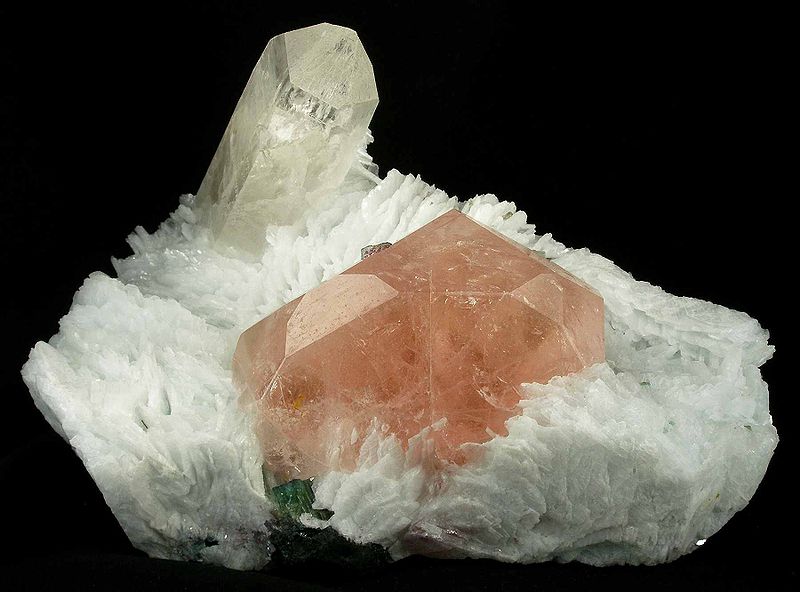

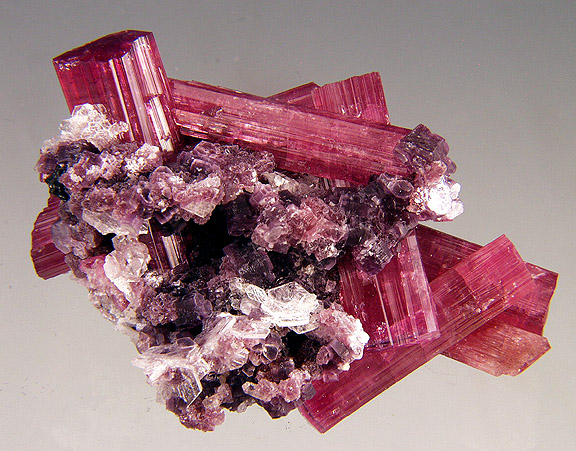
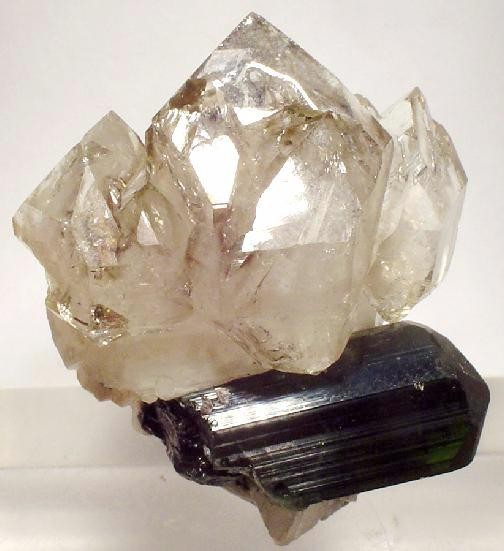
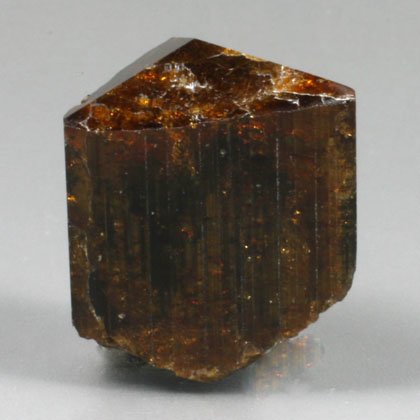

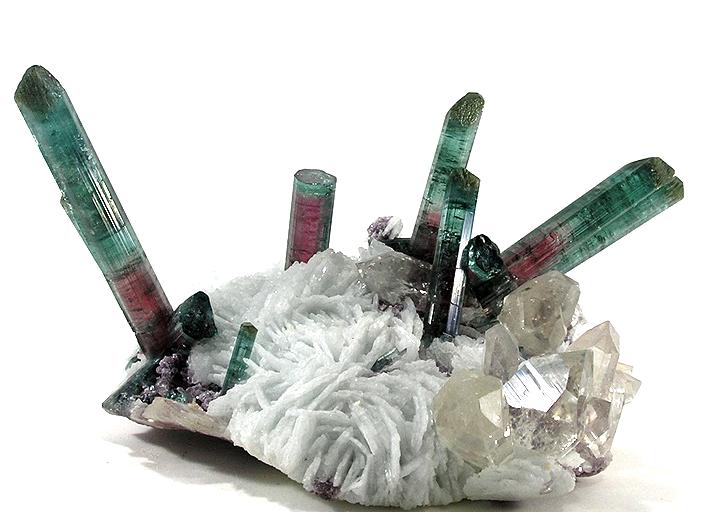
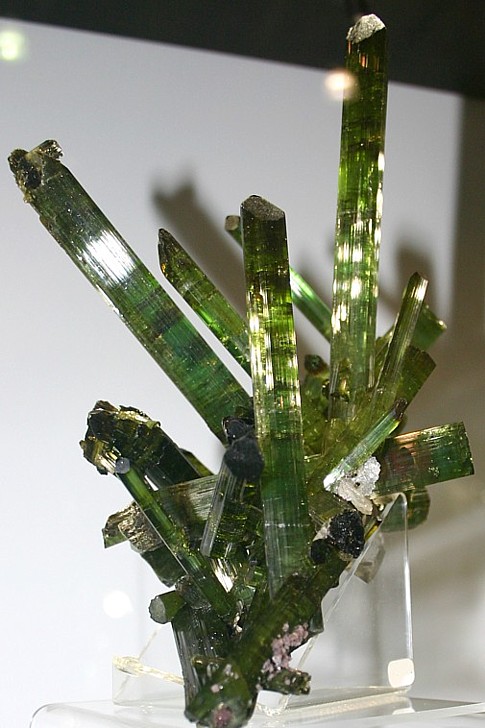
One of the most remarkable aspects of tourmaline is its incredible color range. It can be found in almost every color of the rainbow, including green, blue, red, pink, yellow, brown, black, and even colorless varieties. Some tourmalines even exhibit multiple colors within a single crystal, referred to as “bi-color” or “watermelon” tourmalines. This extensive color palette makes tourmaline a popular choice among gem enthusiasts and jewelry designers.
Tourmaline derives its name from the Sinhalese word “turmali,” which means “mixed colors.” This name aptly reflects the gem’s diverse range of hues. The gemstone has been known to various cultures for centuries, but it gained popularity in Europe during the 18th century when it was imported from Sri Lanka.
Apart from its captivating colors, tourmaline exhibits interesting optical properties. Many tourmaline crystals have a property called pleochroism, meaning they can display different colors when viewed from different angles. This optical phenomenon adds to the gemstone’s allure and makes each piece unique.
Tourmaline is also renowned for its electric properties. When subjected to heat or pressure, it develops an electrical charge at its ends, resulting in the polarization of the crystal. This phenomenon, known as pyroelectricity and piezoelectricity, respectively, has made tourmaline valuable in scientific instruments and industrial applications.
Beyond its aesthetic and physical properties, tourmaline has gained popularity in the realm of metaphysics and holistic healing. Different colors of tourmaline are believed to possess specific energy properties that can influence various aspects of life, such as promoting love, enhancing creativity, providing protection, and balancing the chakras.
Tourmaline deposits can be found in several countries worldwide, including Brazil, Sri Lanka, Afghanistan, Nigeria, Madagascar, and the United States. Each location yields unique variations in color and quality, adding to the diversity of tourmaline available in the market.
In conclusion, tourmaline is a captivating gemstone prized for its stunning colors, unique optical properties, and metaphysical attributes. Whether you appreciate its beauty, seek its energetic qualities, or simply enjoy its versatility in jewelry, tourmaline continues to fascinate and inspire people around the world.
Physical properties and characteristics
Tourmaline possesses several distinct physical properties and characteristics that contribute to its uniqueness as a gemstone. Here are some of the notable features:
- Hardness: Tourmaline ranks 7 to 7.5 on the Mohs scale of mineral hardness. This places it relatively high on the scale, indicating that it is quite durable and resistant to scratches. However, it is important to note that tourmaline’s hardness can vary depending on its specific composition and structure.
- Crystal Structure: Tourmaline crystallizes in the trigonal system, forming prismatic crystals with a triangular cross-section. These crystals can vary in size and shape, ranging from elongated columns to stubby hexagonal prisms. The crystals may be transparent, translucent, or opaque, depending on the presence of impurities and inclusions.
- Color Variations: One of the remarkable characteristics of tourmaline is its wide range of colors. It can exhibit nearly every color of the spectrum, including green, blue, red, pink, yellow, brown, black, and colorless varieties. The presence of trace elements and impurities within the crystal structure contributes to the diverse color palette observed in tourmaline.
- Pleochroism: Many tourmaline crystals display pleochroism, which means they exhibit different colors when viewed from different angles. This optical phenomenon is a result of variations in light absorption and transmission within the crystal. The pleochroic effect can enhance the gemstone’s visual appeal and create interesting color play.
- Luster: Tourmaline typically possesses a vitreous to resinous luster when cut and polished. This luster enhances the gemstone’s shine and brilliance, contributing to its overall aesthetic appeal.
- Specific Gravity: The specific gravity of tourmaline ranges from approximately 3.02 to 3.26. This property refers to the ratio of the gemstone’s density to the density of water. The specific gravity can help distinguish tourmaline from other gemstones with similar appearances.
- Electrical Properties: Tourmaline exhibits unique electrical properties known as pyroelectricity and piezoelectricity. Pyroelectricity refers to its ability to generate an electric charge when heated or cooled, while piezoelectricity refers to its capacity to generate an electric charge under mechanical stress. These properties have practical applications in scientific instruments and various technological devices.
- Cleavage: Tourmaline has poor to indistinct cleavage, which means it tends to fracture rather than break along well-defined planes. This can make the gemstone somewhat challenging to cut and shape, but it also contributes to its durability.
These physical properties and characteristics make tourmaline a versatile and intriguing gemstone that continues to captivate gem enthusiasts and jewelry connoisseurs around the world.
Composition and Crystal Structures
The composition and crystal structure of tourmaline contribute to its unique properties and appearance. Tourmaline is a complex borosilicate mineral, and its composition can vary depending on the specific chemical elements present. The general chemical formula for tourmaline is (Na,Ca)(Li,Mg,Fe^2+,Fe^3+,Mn^2+)_3Al_6(BO_3)_3Si_6O_18(OH,F)_4.
The crystal structure of tourmaline belongs to the cyclosilicate group, specifically the trigonal system. Tourmaline crystals typically form long prismatic structures with a triangular cross-section. These crystals are classified as complex aluminum borosilicates.
Within the crystal structure, tourmaline consists of columns of linked tetrahedra, with silicon and oxygen forming the main framework. The boron atoms substitute for some of the silicon atoms, and the aluminum atoms occupy positions within the framework. Various other elements, such as sodium, calcium, lithium, magnesium, iron, and manganese, can substitute for one another, leading to the diverse range of tourmaline varieties.
The crystal structure of tourmaline also contributes to its unique optical properties. The arrangement of atoms within the crystal lattice affects the gemstone’s ability to transmit, reflect, and absorb light, resulting in the display of various colors and pleochroism.
It’s important to note that the specific composition and crystal structure of tourmaline can vary depending on the presence of different chemical elements and impurities. This variability leads to the vast range of colors and properties observed in tourmaline gemstones. The crystal structure and chemical composition contribute to the gem’s beauty, durability, and distinct characteristics, making tourmaline a highly sought-after and valued gemstone in the world of jewelry and gemology.
Occurrence and mining
Tourmaline can be found in various locations around the world, and its occurrence is widespread. Some notable sources of tourmaline include:
- Brazil: Brazil is one of the major producers of tourmaline, particularly the states of Minas Gerais and Bahia. Brazilian tourmaline deposits yield a wide range of colors, including the popular Paraíba tourmalines known for their vivid blue and green hues.
- Sri Lanka: Sri Lanka, historically known as Ceylon, has been a significant source of tourmaline for centuries. The country’s gem-rich regions, such as Ratnapura and Elahera, produce a variety of tourmalines in different colors, including pink, green, and blue.
- Nigeria: Nigeria has emerged as a notable source of tourmaline, particularly in the state of Oyo. Nigerian tourmalines are known for their vibrant colors, including shades of green, pink, and blue.
- Madagascar: Madagascar is renowned for its production of tourmaline, with deposits found in various regions, such as Antsirabe and Ilakaka. The country yields a diverse range of tourmaline colors, including vibrant pinks, greens, and bi-color specimens.
- Afghanistan and Pakistan: Both Afghanistan and Pakistan are known for their significant tourmaline deposits. In Afghanistan, the Panjshir Valley is famous for its pink and red tourmalines, while the northern areas of Pakistan, such as Gilgit-Baltistan, produce a variety of tourmaline colors, including green, blue, and pink.
- United States: The United States has several locations where tourmaline is found. California, Maine, and New York are known for producing high-quality tourmalines in various colors, such as pink, green, and blue.
Tourmaline is typically mined through traditional methods, such as open-pit mining or underground mining, depending on the location and deposit type. In some cases, gemstone miners may use manual labor, while in other instances, mechanized techniques and equipment are employed.
Once extracted from the earth, the rough tourmaline is sorted, graded, and prepared for cutting and polishing. Skilled lapidaries shape the rough into various gemstone cuts, such as faceted gems, cabochons, or beads, depending on the desired end product.
It’s worth mentioning that due to the popularity and demand for certain tourmaline colors, such as Paraíba tourmalines, there have been instances of unethical mining practices and concerns regarding environmental impact. As a result, responsible sourcing and fair trade practices are encouraged within the gemstone industry to ensure sustainable mining and ethical supply chains for tourmaline and other gemstones.
Formation of Tourmaline
Tourmaline forms through a complex geological process involving a combination of heat, pressure, and chemical reactions. The exact formation of tourmaline can vary depending on the specific geological setting, but here is a general overview of its formation:
- Igneous Stage: The formation of tourmaline often begins with the crystallization of magma deep within the Earth’s crust. As magma cools and solidifies, it forms igneous rocks such as granite, pegmatite, and volcanic rocks. The presence of certain chemical elements and minerals within the magma is crucial for the subsequent formation of tourmaline.
- Hydrothermal Stage: After the initial igneous stage, the formation of tourmaline continues during hydrothermal processes. Hot fluids rich in various elements, such as boron, lithium, and other components necessary for tourmaline formation, circulate through fractures and cavities within the surrounding rocks. These fluids are often derived from the cooling and crystallization of magma.
- Metamorphic Stage: As the hydrothermal fluids percolate through the rocks, they can encounter zones of metamorphism. Metamorphism occurs when rocks undergo changes in temperature, pressure, and chemical composition due to tectonic forces or other geological processes. During metamorphism, the fluids react with the surrounding minerals, exchanging ions and elements and facilitating the growth of tourmaline crystals.
- Crystallization and Growth: Within the hydrothermal fluids, the necessary elements for tourmaline crystallization combine in the right conditions. The fluids provide the necessary constituents, including boron, aluminum, silicon, and various trace elements, for tourmaline crystal growth. As the fluids cool and pressure changes occur, tourmaline crystals begin to form within fractures, cavities, or along the grain boundaries of the host rocks.
The specific chemical composition of the surrounding rocks, the availability of boron and other necessary elements, the temperature, pressure conditions, and the duration of the hydrothermal process all influence the color and characteristics of the tourmaline crystals formed.
It’s important to note that tourmaline can also form through other processes, such as through the alteration of pre-existing minerals containing boron or by the replacement of other minerals by tourmaline. The formation of tourmaline is a complex interplay of geological factors and requires specific conditions to produce the diverse range of colors and variations observed in this gemstone.
Types and Varieties of Tourmaline
Tourmaline exhibits a wide range of colors and varieties, making it a gemstone with abundant diversity. Here are some of the notable types and varieties of tourmaline:
- Rubellite: Rubellite is a variety of tourmaline that displays vibrant pink to red colors. It is one of the most valued and sought-after varieties of tourmaline due to its intense and rich hues.
- Indicolite: Indicolite is the blue variety of tourmaline. It can range from light blue to deep blue-green shades. The color intensity and saturation can vary, with some specimens exhibiting a striking teal or turquoise appearance.
- Paraíba: Paraíba tourmaline is a variety known for its intense neon blue to greenish-blue colors. It gained prominence in the 1980s when deposits were discovered in the Brazilian state of Paraíba. Paraíba tourmalines are highly valued and coveted for their vivid hues.
- Watermelon Tourmaline: Watermelon tourmaline refers to tourmaline crystals that exhibit a distinct color zoning resembling a watermelon slice. Typically, the crystals display a pink or red core surrounded by a green outer layer. This variety is highly prized for its unique and eye-catching appearance.
- Canary Tourmaline: Canary tourmaline is characterized by its bright yellow to golden hues. This variety is relatively rare and highly valued for its vibrant and sunny colors.
- Chrome Tourmaline: Chrome tourmaline is renowned for its vibrant green colors. It owes its green hue to the presence of chromium within the crystal structure. The finest specimens exhibit a rich, emerald-like green.
- Schorl: Schorl is the most common and abundant variety of tourmaline. It is typically black or dark in color and is widely used in various industrial applications.
- Bi-Color Tourmaline: Bi-color tourmaline refers to crystals that exhibit two or more distinct colors within a single specimen. Common combinations include pink and green, pink and blue, and green and blue. The color zoning can occur in various patterns, such as concentric bands or distinct sections.
- Cat’s Eye Tourmaline: Cat’s eye tourmaline displays chatoyancy, an optical phenomenon that produces a distinct band of light resembling a cat’s eye when the stone is cut en cabochon. This effect is caused by the alignment of needle-like inclusions within the crystal.
- Colorless Tourmaline: Colorless tourmaline, also known as achroite, is a transparent variety that lacks any significant color. It is valued for its clarity and can be used as a diamond substitute.
These are just a few examples of the many tourmaline varieties and color variations available. Each variety of tourmaline has its own distinct charm and allure, contributing to the gemstone’s enduring popularity in the world of gemology and jewelry.
Rare and unique varieties
In addition to the commonly known varieties of tourmaline, there are several rare and unique varieties that are highly prized among collectors and gem enthusiasts. Here are some of the rare and unique varieties of tourmaline:
- Paraíba Tourmaline: As mentioned earlier, Paraíba tourmaline is renowned for its intense neon blue to greenish-blue colors. It is considered one of the rarest and most valuable varieties of tourmaline due to its vibrant hues and limited availability. The original Paraíba deposits in Brazil are known for their exceptional color saturation.
- Cuprian Tourmaline: Cuprian tourmaline is a variety that contains a significant amount of copper in its composition, resulting in striking blue and green colors. These gemstones often exhibit similar hues to Paraíba tourmalines but may have variations in color intensity and composition. Cuprian tourmalines are highly valued and prized for their vivid colors.
- Indicolite with Copper: This variety of tourmaline combines the blue hues of indicolite with the presence of copper, resulting in unique and exceptional color combinations. The addition of copper imparts turquoise, teal, or greenish-blue shades to the gemstone, creating a captivating and rare variety.
- Chrome-Dravite: Chrome-dravite is a variety of tourmaline that contains chromium and iron, resulting in a deep green color. This rare variety is characterized by its intense green hue and is highly sought after by collectors and gemstone enthusiasts.
- Red Tourmaline (Rubellite): While rubellite is a well-known variety of tourmaline, truly exceptional red tourmalines are considered rare. Rubellites with vibrant, pure red colors and high clarity are highly prized and valued for their rarity.
- Paraíba-like Tourmaline: Some tourmalines from other localities, such as Mozambique and Nigeria, have been discovered with similar colors and characteristics to Paraíba tourmalines. Although they are not from the original Paraíba deposit, they are often referred to as Paraíba-like tourmalines and are considered rare and valuable.
- Color-Change Tourmaline: Color-change tourmaline is a unique variety that exhibits different colors under different lighting conditions. It can display a range of hues, such as green under daylight and red or pink under incandescent light. This color-changing property adds to the desirability and rarity of these tourmalines.
These rare and unique varieties of tourmaline are highly sought after by gemstone connoisseurs and collectors due to their exceptional colors, distinct properties, and limited availability. The rarity of these varieties often contributes to their high market value and desirability among gemstone enthusiasts.
History and Cultural Significance
Tourmaline has a rich history and cultural significance that spans centuries and various civilizations. Here are some highlights of its history and cultural significance:
- Ancient Civilizations: The use of tourmaline can be traced back to ancient civilizations. It is believed that the Egyptians and Romans valued tourmaline for its vibrant colors and believed it possessed mystical and protective properties. They carved talismans and amulets from tourmaline, often associating it with strength, vitality, and spiritual energy.
- Asian Cultures: In Asia, tourmaline has been highly revered throughout history. In China, tourmaline was associated with the yin and yang energies and was used in traditional medicine to treat various ailments. It was also considered a stone of protection and used to ward off negative energies. In Japan, tourmaline was believed to bring good fortune and was cherished for its beautiful colors.
- Indigenous Cultures: Many indigenous cultures have cherished tourmaline and attributed spiritual significance to the stone. For example, Native Americans considered tourmaline to be a sacred stone that brought protection and healing. It was often used in rituals, ceremonies, and as a talisman for spiritual guidance.
- European Renaissance: During the European Renaissance, tourmaline gained popularity among nobility and the upper class. Its vibrant colors were highly valued, and it became a fashionable gemstone for jewelry, adornments, and accessories. It was also believed to have various healing properties and was used in herbal remedies and elixirs.
- Modern Era: In the 19th and 20th centuries, significant discoveries of tourmaline deposits in Brazil and other countries increased its availability and popularity. Tourmaline became a favored gemstone among jewelry designers and collectors, known for its wide range of colors and versatility. The discovery of Paraíba tourmalines in Brazil in the 1980s created a sensation in the gemstone world, elevating tourmaline’s desirability and value.
Today, tourmaline continues to be cherished and valued for its exceptional beauty and diversity. It is considered a birthstone for October and is often used in contemporary jewelry designs. Its historical and cultural significance, combined with its striking colors and metaphysical properties, make tourmaline a beloved gemstone with enduring appeal across various cultures and generations.
Gemological Aspects of Tourmaline
Tourmaline is a fascinating gemstone with several gemological aspects that contribute to its beauty, value, and identification. Here are some key gemological aspects of tourmaline:
- Color: Tourmaline is renowned for its wide range of colors, which are influenced by the presence of different trace elements and impurities. The color spectrum of tourmaline includes pink, red, green, blue, yellow, brown, and colorless varieties, among others. Some tourmalines also exhibit bi-color or tri-color zoning, adding to their uniqueness.
- Pleochroism: Tourmaline is pleochroic, meaning it can display different colors when viewed from different angles. Gemologists often examine tourmaline specimens under a dichroscope to observe the varying colors exhibited by the gemstone.
- Clarity: Tourmaline can range from transparent to translucent. Inclusions, such as needle-like tubes, liquid-filled cavities (known as “fingerprints”), or mineral crystals, may be present within the gemstone. The clarity of tourmaline is assessed based on the visibility and impact of these inclusions on the overall appearance of the stone.
- Cut and Shape: Tourmaline can be cut into various gemstone shapes, such as faceted gems, cabochons, or beads, depending on the desired result. Gem cutters consider the crystal shape, color distribution, and clarity of the rough tourmaline to determine the most suitable cut.
- Optical Properties: Tourmaline has interesting optical properties. It has a refractive index ranging from approximately 1.61 to 1.68, and its birefringence (the difference between the two refractive indices) ranges from 0.014 to 0.040, depending on the specific variety. These optical properties influence how light interacts with the gemstone and contribute to its brilliance and fire.
- Durability: Tourmaline has a Mohs hardness of 7 to 7.5, making it relatively durable and suitable for most jewelry settings. However, it is still important to protect tourmaline from hard blows, chemicals, and extreme temperature changes to maintain its beauty and integrity.
- Treatment: Tourmaline can undergo various treatments to enhance its color and clarity. Heat treatment is commonly used to improve the color and remove brownish tones. Some tourmalines are also irradiated to alter or enhance their color. It is essential for gemstone sellers to disclose any treatments applied to the tourmaline.
- Identification: Gemological laboratories and experts utilize various instruments, such as spectroscopes, refractometers, polariscopes, and advanced imaging techniques, to identify and assess the authenticity, origin, and characteristics of tourmaline.
Understanding these gemological aspects is crucial for gemologists, jewelers, and buyers to evaluate, appreciate, and value tourmaline gemstones accurately. Each aspect contributes to the overall beauty, quality, and uniqueness of tourmaline as a cherished and sought-after gemstone.
Major Deposits and Mining Locations
Tourmaline deposits can be found in various parts of the world. Here are some major deposits and mining locations known for producing high-quality tourmaline:
- Brazil: Brazil is one of the world’s largest producers of tourmaline, and it is particularly famous for its Paraíba tourmaline. The state of Paraíba in Brazil became known for its exceptional neon blue to greenish-blue tourmalines in the late 1980s. Other significant tourmaline-producing states in Brazil include Minas Gerais, Bahia, and Rio Grande do Norte.
- Afghanistan: Afghanistan is renowned for its rich deposits of tourmaline. The Panjshir Valley and Nuristan region in Afghanistan are known for producing fine-quality pink, red, and green tourmalines.
- Nigeria: Nigeria is recognized for its high-quality tourmaline deposits. The state of Oyo is particularly known for producing vibrant and valuable Paraíba-like blue and green tourmalines.
- Mozambique: Mozambique has become an important source of tourmaline in recent years. The country is known for producing various colors of tourmaline, including Paraíba-like blue and green, as well as pink and red tourmalines.
- Madagascar: Madagascar is a significant tourmaline producer, with deposits found in various regions such as Antsirabe, Betafo, and Andilamena. Madagascar is known for its diverse range of tourmaline colors, including vibrant pinks, blues, and greens.
- United States: The United States has several tourmaline-producing locations. Notable deposits include California, Maine, and Connecticut. California, particularly the San Diego County region, is known for producing high-quality pink, green, and bicolor tourmalines.
- Namibia: Namibia is recognized for its tourmaline deposits, with the Erongo region being the most notable. Namibian tourmalines often exhibit rich colors, including intense pinks and greens.
- Russia: Russia has historically been a significant producer of tourmaline. The Ural Mountains region is known for producing tourmalines in various colors, including green, pink, and blue.
- Sri Lanka: Sri Lanka has long been known for its gemstone deposits, and tourmaline is among the gemstones found there. Sri Lankan tourmalines are known for their wide range of colors, including blue, green, pink, and bi-colors.
These are just a few examples of the major tourmaline deposits and mining locations around the world. Tourmaline can be found in many other countries as well, including Myanmar, Pakistan, Kenya, Tanzania, and Zambia. The specific characteristics and colors of tourmaline can vary depending on the location, providing a diverse range of options for gemstone enthusiasts and jewelry designers.
Uses of Tourmaline
Tourmaline is a versatile gemstone with a wide range of uses across various industries. Here are some of the common uses of tourmaline:
- Jewelry: Tourmaline is highly valued as a gemstone and is widely used in jewelry. It is cut into various shapes, including faceted gemstones, cabochons, beads, and carved ornaments. Tourmaline’s wide range of colors and unique color combinations make it a popular choice for rings, necklaces, earrings, bracelets, and other forms of jewelry.
- Healing and Metaphysical Purposes: Tourmaline has been associated with various healing and metaphysical properties. Different colors of tourmaline are believed to have specific energetic properties and are used for different purposes. For example, pink tourmaline is often associated with emotional healing and love, while green tourmaline is associated with physical vitality and abundance. Tourmaline is used in alternative and holistic healing practices, such as crystal healing, meditation, and chakra balancing.
- Electrical and Scientific Applications: Certain varieties of tourmaline, such as elbaite, possess unique electrical properties. They exhibit piezoelectric and pyroelectric properties, meaning they generate an electrical charge when subjected to pressure or temperature changes. This makes tourmaline valuable in the production of sensitive electronic components, such as pressure sensors, accelerometers, and sonar devices. It is also used in scientific instruments, including X-ray detectors and spectrometers.
- Industrial Uses: Black tourmaline (schorl) is widely used in various industrial applications. It is used as an abrasive material in grinding and polishing operations. Schorl is also used in the production of mineral specimens, black pigments, and as a component in ceramic glazes.
- Grounding and EMF Protection: Black tourmaline is often sought after for its grounding properties and its ability to absorb and deflect electromagnetic frequencies (EMFs). It is used in various forms, such as pyramids, spheres, or wearable jewelry, to provide protection against electromagnetic radiation emitted by electronic devices.
- Decorative and Collectible Items: Tourmaline specimens, both rough and polished, are collected and admired for their natural beauty and unique formations. They are often displayed as decorative pieces or incorporated into art and sculpture.
- Lapidary and Gemstone Cutting: Tourmaline rough is used by lapidaries and gemstone cutters to create gem-quality faceted stones, cabochons, and other custom-cut gemstones. Skilled artisans work with tourmaline to bring out its best color, clarity, and shape, transforming rough material into finished gemstones for jewelry or collector’s items.
These are just a few examples of the many uses of tourmaline. Its vibrant colors, unique properties, and availability in different forms make it a versatile gemstone with applications ranging from fashion and aesthetics to technology and metaphysics.
Care and Maintenance of Tourmaline
Tourmaline is a relatively durable gemstone, but proper care and maintenance can help preserve its beauty and longevity. Here are some guidelines for caring for tourmaline:
- Avoid Harsh Chemicals: Tourmaline can be sensitive to harsh chemicals, so it’s best to avoid exposing it to substances like bleach, acids, and harsh cleaning agents. These chemicals can potentially damage the gemstone or its setting. Instead, clean tourmaline jewelry with mild soapy water and a soft brush, and rinse thoroughly.
- Avoid Extreme Temperatures: Tourmaline can be sensitive to sudden temperature changes. Avoid subjecting your tourmaline jewelry to extreme heat or rapid temperature fluctuations, as it can cause thermal shock and potentially damage the gemstone.
- Protection from Scratches: While tourmaline is relatively hard (Mohs hardness of 7 to 7.5), it can still be scratched by harder materials. To prevent scratches, store your tourmaline jewelry separately from other jewelry items or materials that could potentially scratch the gemstone. Consider keeping tourmaline pieces in individual pouches or compartments.
- Avoid Impact and Rough Handling: Tourmaline can chip or fracture if subjected to hard impacts or rough handling. It is important to handle tourmaline jewelry with care, especially when taking it off or putting it on. Avoid wearing tourmaline jewelry during activities that could expose it to potential impacts, such as sports or heavy physical work.
- Regular Cleaning: To maintain the brilliance and shine of tourmaline, regular cleaning is recommended. Gently clean the gemstone with a soft brush, mild soapy water, and rinse thoroughly. Avoid using ultrasonic cleaners or steam cleaning methods, as they may not be suitable for certain tourmaline varieties or treatments.
- Protective Storage: When not in use, store your tourmaline jewelry in a soft pouch or jewelry box to protect it from scratches, dust, and sunlight. Avoid exposing tourmaline jewelry to prolonged sunlight or direct heat, as it can cause color fading or damage over time.
- Periodic Professional Inspection: It is a good idea to have your tourmaline jewelry inspected by a professional jeweler periodically. They can check the gemstone settings, prongs, and overall condition of the piece to ensure everything is secure and in good shape.
By following these care and maintenance guidelines, you can help preserve the beauty and quality of your tourmaline jewelry for years to come.
Famous Tourmaline Specimens and Collections
Tourmaline is a gemstone that has captivated the attention of gem enthusiasts and collectors around the world. Several famous tourmaline specimens and collections have gained recognition for their exceptional beauty and rarity. Here are a few notable examples:
- The Empress Dowager Necklace: This renowned necklace features a strand of large, polished pink tourmaline beads. It once belonged to the Empress Dowager Cixi of China, who ruled during the late Qing Dynasty. The necklace is an exquisite example of tourmaline’s beauty and was a treasured piece in the royal collection.
- The Kunzite Necklace: The Kunzite Necklace, also known as the “Necklace of the Stars,” is a masterpiece created by jewelry designer Tiffany & Co. It features a stunning pendant adorned with a large, pink kunzite gemstone, surrounded by diamonds and tourmalines. The use of tourmaline in this necklace adds a vibrant touch to the overall design.
- The “Rocket Pocket” Specimen: This is a famous tourmaline specimen discovered in the early 2000s in the Pederneira Mine in Brazil. It gained its nickname due to its distinctive rocket-shaped formation. The Rocket Pocket specimen showcases a variety of colors, including green, pink, and blue tourmaline crystals, making it a highly sought-after and visually captivating piece.
- The Gachala Emerald: The Gachala Emerald is a renowned emerald crystal from Colombia that is recognized for its exceptional size and color. It is named after the town of Gachala, where it was discovered. Within the emerald crystal, there are stunning inclusions of pink and green tourmaline, which add to its unique beauty and rarity.
- The Elbaite Collection at the Harvard Mineralogical Museum: The Harvard Mineralogical Museum houses an extensive collection of tourmaline specimens, including an impressive assortment of elbaite crystals. The collection showcases various colors and forms of tourmaline, providing a comprehensive display of this gemstone’s diversity and beauty.
- The Dravite Tourmaline Collection at the Canadian Museum of Nature: The Canadian Museum of Nature in Ottawa, Canada, houses an exceptional collection of dravite tourmaline specimens. The collection includes a wide range of dravite crystals, showcasing their distinct brown coloration and unique crystal structures.
These are just a few examples of famous tourmaline specimens and collections that have gained recognition for their exceptional beauty and significance. They highlight the unique and captivating nature of tourmaline as a gemstone that has fascinated collectors and gem enthusiasts throughout history.
FAQs
What is the meaning of tourmaline?
Tourmaline is believed to have various meanings and metaphysical properties depending on its color. Generally, tourmaline is associated with protection, healing, and balancing energies. It is often considered a stone that promotes creativity, inspiration, and emotional well-being.
How is tourmaline formed?
Tourmaline is formed in igneous and metamorphic rocks under high temperature and pressure conditions. It crystallizes from mineral-rich solutions that infiltrate the surrounding rocks. The presence of various elements and trace impurities during its formation gives tourmaline its wide range of colors.
Can tourmaline change color?
Some tourmaline varieties, particularly certain blue and green ones, can exhibit color changes under different lighting conditions. This phenomenon is called pleochroism, where the gemstone appears to change color when viewed from different angles.
Is tourmaline treated or enhanced?
Tourmaline can undergo various treatments to enhance its color and clarity. Heat treatment is commonly applied to improve the color and remove undesirable brownish tones. Some tourmalines are also irradiated to alter or enhance their color. It is important for sellers to disclose any treatments applied to the tourmaline.
Can tourmaline be used in engagement rings?
Yes, tourmaline can be used in engagement rings and other types of jewelry. It is a durable gemstone with a hardness of 7 to 7.5 on the Mohs scale, making it suitable for everyday wear. However, due to its relatively lower hardness compared to diamonds, it is important to consider protective settings and handle tourmaline engagement rings with care.
How do I clean tourmaline jewelry?
To clean tourmaline jewelry, use a mild soapy water solution and a soft brush. Gently scrub the gemstone to remove any dirt or debris. Rinse the jewelry thoroughly with clean water and pat dry with a soft cloth. Avoid using harsh chemicals or ultrasonic cleaners, as they may damage the gemstone or its setting.
What are the different varieties of tourmaline?
Tourmaline occurs in various colors and varieties. Some of the well-known tourmaline varieties include:
- Rubellite: Pink to red tourmaline.
- Paraíba: A rare and highly valuable neon blue to greenish-blue tourmaline.
- Watermelon: Tourmaline with a pink center and green outer rim, resembling a watermelon slice.
- Indicolite: Blue tourmaline.
- Verdelite: Green tourmaline.
- Dravite: Brown tourmaline.
- Schorl: Black tourmaline.
Can tourmaline be faceted?
Yes, tourmaline is a popular gemstone for faceting. Its wide range of colors and high transparency make it suitable for cutting into faceted gemstones, which are used in various types of jewelry.
Are there any famous tourmaline gemstones?
Yes, there are several famous tourmaline gemstones, such as the Empress Dowager Necklace, the Kunzite Necklace, and the Rocket Pocket specimen. These gemstones have gained recognition for their exceptional beauty, unique formations, or historical significance.




































